中文、英文字库在触摸屏显示效果
本次测试是在Tslib原来基础上添加汉字显示的代码,显示代码添加在fbutils.c和fbutils.h中,测试代码在ts_test.c中添加。编译Tslib命令如下:
$ git clone https://github.com/kergoth/tslib # 下载 $ cd tslib # 进入tslib目录 $ ./autogen.sh # 产生autotool必要文件 $ ./configure --host=arm-linux --prefix=/home/latelee/lib/tslib # 配置及指定安装目录 $ make # 编译 $ make install # 安装到指定目录
ts_test。
本页面只显示测试效果,无实际代码及其讲解。本次研究最终版本代码示例附于文后,本文作者对代码保留一些权利,使用代码者风险自担(如代码中的bug),作者对代码的进一步修改无须通知他人。 由于代码、效果图均已公布,恕本人无义务提供技术支持。
效果图均由fb2png程序截图获取,使用命令如下:
./fb2png /dev/fb0 test_s_new.png 1 240 320 16
命令解释:
/dev/fb0 :帧缓冲(frame buffer)设备名称 test_s_new.png :图片文件名称 1 :延时 240 320 :水平、垂直大小(即长、宽) 16 :颜色值(经测试,不能为24)
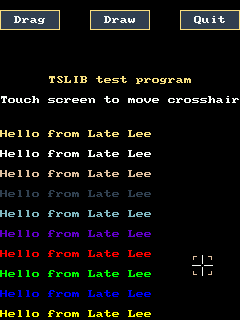



24*24点阵宋体:
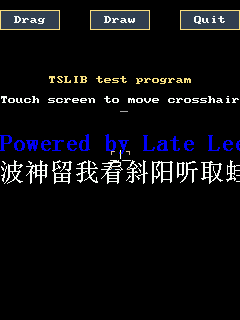
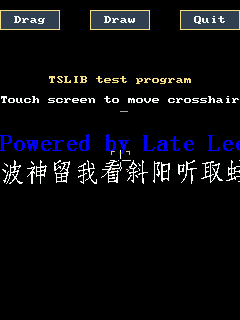

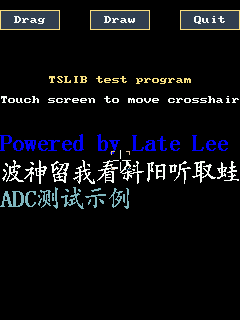
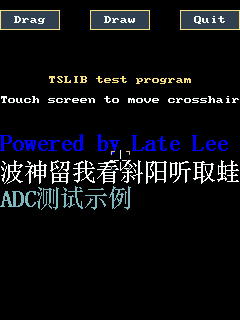
另外两张:


由于24点阵汉字库中没有中文字符(如“◆ □ ■ △ ▲”等等,因此显示失败。),同样,由于所用的汉字字库为GB2312,不在此字符集中的汉字显示失败。
解决方法:
1、使用其它能兼容更多汉字的字库;
2、在代码中跳过这些不能正常显示的中文字符。
/* new add by Late Lee */ /* ascii code */ void put_string_ascii(int x, int y, char *s, unsigned colidx); void put_string_center_ascii(int x, int y, char *s, unsigned colidx); /* cineses character */ void put_string_hz(FILE *fp, int x, int y, unsigned char *s, unsigned colidx); void put_string_center_hz(FILE *fp, int x, int y, unsigned char *s, unsigned colidx); /* chineses character & ascii */ void put_font(FILE *fp, int x, int y, unsigned char *s, unsigned colidx); void put_font_center(FILE *fp, int x, int y, unsigned char *s, unsigned colidx); /* end of new add */
/* new add by Late Lee 2011-05-30*/
//#define HZK24
#ifdef HZK24 /* 24 */
#include "ascii24.h"
#define ASCII_CODE ascii24
#define FONT_SIZE 24 /* size: 24 */
#else /* 16 */
#include "ascii16.h"
#define ASCII_CODE ascii16
#define FONT_SIZE 16 /* size: 16 */
#endif
#define BYTES (FONT_SIZE/8) /* for HZ: 3 bytes 2 bytes*/
#define BUF_SIZE (BYTES * FONT_SIZE) /* HZ buff 3*24 = 72 bytes 2*16 = 32 bytes */
#define ASCII_BYTES (BYTES-1) /* 2 1*/
#define ASCII_SIZE (FONT_SIZE * ASCII_BYTES) /* ASCII buffer: 24*2 = 48 bytes 16 * 1 = 16 bytes */
#define ASCII_WIDTH (FONT_SIZE/2) /* ASCII: 16*8 24*12 */
/* end here Late Lee*/
/*****************************************************************************
* new add by Late Lee 2011-05-30
*****************************************************************************/
/**
* __display_ascii - Display an ASCII code on touch screen
* @x: Column
* @y: Row
* @ascii: Which ASCII code to display
* @colidx: Color index(?)
* This routine display an ASCII code that stored in an array(eg, ASCII_CODE).
* 16x8 ASCII code takes 1 byte, 24*12 ASCII code takes 2 bytes, so we need
* -ASCII_BYTES-.
*/
static void __display_ascii(int x, int y, char *ascii, unsigned colidx)
{
int i, j, k;
unsigned char *p_ascii;
int offset;
offset = (*ascii - 0x20 ) * ASCII_SIZE; /* find the code in the array */
p_ascii = ASCII_CODE + offset;
for(i=0;i<FONT_SIZE;i++)
for(j=0;j<ASCII_BYTES;j++)
for(k=0;k<8;k++)
if( p_ascii[i*ASCII_BYTES+j] & (0x80>>k) )
//if(*( p_ascii + i*ASCII_BYTES+j) & (0x80>>k))
pixel (x + j*8 + k, y + i, colidx);
}
/**
* put_string_ascii - Display an ASCII string on touch screen
* @x: Column
* @y: Row
* @s: Which string to display
* @colidx: Color index
*/
void put_string_ascii(int x, int y, char *s, unsigned colidx)
{
while (*s != 0) {
__display_ascii(x, y, s, colidx);
x += ASCII_WIDTH;
s++;
}
}
/* not test */
void put_string_center_ascii(int x, int y, char *s, unsigned colidx)
{
size_t sl = strlen (s);
put_string_ascii (x - (sl / 2) * ASCII_WIDTH,
y - FONT_SIZE / 2, s, colidx);
}
/**
* __display_font_16 - Display a 16x16 (chinese) character on touch screen
* @fp: File pointer points to HZK(ie, HZK16)
* @x: Column
* @y: Row
* @font: Which (chinese) character to display
* @colidx: Color index
* This routine ONLY display 16*16 character.
* Every character takes two bytes, we show the first 8 bits, then the second 8 bits,
* then the whole world will be shown before us.
*/
static void __display_font_16 (FILE *fp, int x, int y, unsigned char *font, unsigned colidx)
{
int i, j, k;
unsigned char mat[BUF_SIZE]={0};
int qh,wh;
unsigned long offset;
qh = *font - 0xa0;
wh = *(font+1) - 0xa0;
offset = ( 94*(qh-1) + (wh-1) ) * BUF_SIZE; /* offset of the character in HZK */
/* read it */
fseek(fp,offset,SEEK_SET);
fread(mat,BUF_SIZE,1,fp);
/* show it */
for(i=0;i<FONT_SIZE;i++)
for(j=0;j<BYTES;j++)
for(k=0;k<8;k++)
if(mat [i*BYTES+j] & (0x80>>k))
pixel (x + j*8 + k, y + i, colidx);
}
/**
* __display_font_24 - Display a 24x24 (chinese) character on touch screen
* @fp: File pointer points to HZK(ie, HZK24)
* @x: Column
* @y: Row
* @font: Which (chinese) character to display
* @colidx: Color index
*/
static void __display_font_24 (FILE *fp, int x, int y, unsigned char *font, unsigned colidx)
{
unsigned int i, j;
unsigned char mat[FONT_SIZE][BYTES]=0;
int qh,wh;
unsigned long offset;
qh = *font - 0xaf;
wh = *(font+1) - 0xa0;
offset = ( 94*(qh-1) + (wh-1) ) * BUF_SIZE;
fseek(fp,offset,SEEK_SET);
fread(mat,BUF_SIZE,1,fp);
for(i=0;i<FONT_SIZE;i++)
for(j=0;j<FONT_SIZE;j++)
if( mat[j][i>>3] & (0x80>>(i&7)) )
// if ( mat[j][i/8] & (0x80>>i%8) ) /* org */
pixel (x + j, y + i, colidx);
}
/**
* put_string_hz - Display a (chinese) character string on touch screen
* @fp: File pointer points to HZK(ie, HZK24 or HZK16)
* @x: Column
* @y: Row
* @s: Which string to display(must be 'unsigned char*')
* @colidx: Color index
*/
void put_string_hz (FILE *fp, int x, int y, unsigned char *s, unsigned colidx)
{
while (*s != 0) {
#ifdef HZK24
__display_font_24 (fp, x, y, s, colidx); /* for HZK24 */
#else
__display_font_16 (fp, x, y, s, colidx);
#endif
x += FONT_SIZE;
s += 2; /* 2 bytes */
}
}
/* not test */
void put_string_center_hz (FILE *fp, int x, int y, unsigned char *s, unsigned colidx)
{
size_t sl = strlen ((char *)s);
put_string_hz (fp, x - (sl/2) * FONT_SIZE, y - FONT_SIZE/2, s, colidx);
}
/**
* put_font - Display an ASCII or/and (chinese) character string on touch screen
* @fp: File pointer points to HZK(ie, HZK24 or HZK16)
* @x: Column
* @y: Row
* @s: Which string to display
* @colidx: Color index
*/
void put_font(FILE *fp, int x, int y, unsigned char *s, unsigned colidx)
{
while (*s != 0) {
if ( (*s>0xa0) && (*(s+1)>0xa0) ) {
#ifdef HZK24
__display_font_24 (fp, x, y, s, colidx); /* for HZK24 */
#else
__display_font_16 (fp, x, y, s, colidx); /* for HZK16 */
#endif
x += FONT_SIZE;
s += 2; /* 2 bytes */
} else {
__display_ascii (x, y, (char *)s, colidx);
x += ASCII_WIDTH;
s++; /* 1 byte */
}
}
}
/* not test */
void put_font_center(FILE *fp, int x, int y, unsigned char *s, unsigned colidx)
{
size_t sl = strlen ((char *)s);
put_font (fp, x - (sl/2) * 16, y - 16/2, s, colidx);
}